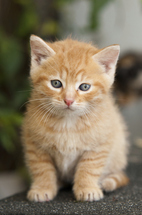Breeding Cats
 Because cats procreate quickly and easily, and because many cats become feral and reproduce in the wild, a tremendous number of cats end up being euthanized every year. Too many cat owners fail to neuter their pets even though they have no intention of breeding them. The result is a vast number of cats without homes, many of which become feral and continue breeding. In the interests of encouraging cat adoption, only responsible and knowledgeable cat owners should consider becoming cat breeders.
Because cats procreate quickly and easily, and because many cats become feral and reproduce in the wild, a tremendous number of cats end up being euthanized every year. Too many cat owners fail to neuter their pets even though they have no intention of breeding them. The result is a vast number of cats without homes, many of which become feral and continue breeding. In the interests of encouraging cat adoption, only responsible and knowledgeable cat owners should consider becoming cat breeders.
Prerequisites for Breeding
There are certain preconditions that should be met before breeding any animal. In order to become a responsible breeder, it is necessary to do some research not only about the particular breed of cat one is interested in, but in the basic principles of genetics.
Before breeding any cat, there are several things to be considered.
Age
A female cat should reach adulthood, 18 to 24 months, before being bred. Although she can bear young before this time, undergoing premature pregnancy may stunt her own growth. The male cat, too, should be full-grown, at least 18 months of age, prior to being used for breeding.
Health Status
Both perspective parents should be evaluated by a veterinarian to ensure that they are healthy. They should be vaccinated, free of external and internal parasites and without any disease conditions.
Their genetic lineage should be considered to make sure they are will not pass heredity abnormalities, such as polycystic kidney disease or hip dysplasia, to their young. Certain cat breeds are prone to particular disorders so it is best to check with experienced breeders before undertaking the project.
When breeding, the female should be at, or close to, her ideal weight because if she is too fat or too thin she may have trouble conceiving, have a difficult pregnancy or have trouble giving birth (queening).
Temperament
The temperament of the two cats should also be evaluated since a good part of temperament is genetically determined. Docility or aggression are traits likely to be passed on to the kittens.
Ovulation
Female cats are seasonally polyestrous, meaning they come into heat during certain seasons of the year. If they are outdoor cats, they will usually come into heat during the spring and summer. Indoor cats may cycle throughout the year. Queens (female cats) must mate before they will ovulate, a condition know as reflex ovulation.
Mating
During the fertile (estrus) period, the queen is taken to the tom for mating. This period comes just after the observable period when the queen calls out to the tom, rolling and rubbing her body on the ground. The queen's estrus period lasts for about a week.
Mating in cats is a very quick process, taking only seconds to complete. Cat breeders have to provide the tom with a way to escape from the female immediately after mating because the female often becomes aggressive just after coitus. For up to an hour she rejects any attention, human or feline, and grooms herself frantically. Immediately thereafter, however, she is receptive to the male again.
Because the female will be receptive to other males during the estrus period, if she is not isolated after the mating, she may give birth to a litter with more than one father, a phenomenon known as superfecundation.
Gestation
 Cats have pregnancies that are approximately 63 days in length. The pregnant cat should be checked by a veterinarian who will give information about nutritional and other needs during gestation. Toward the end of the pregnancy, a safe, quiet, comfortable place should be set aside for the cat to give birth.
Cats have pregnancies that are approximately 63 days in length. The pregnant cat should be checked by a veterinarian who will give information about nutritional and other needs during gestation. Toward the end of the pregnancy, a safe, quiet, comfortable place should be set aside for the cat to give birth.
Cats are as self-sufficient about queening as about most other aspects of their lives and will not require human intervention unless there is a medical problem.
Birth
A clear sign that a cat is about to give birth is that her teats enlarge and begin producing milk. This usually occurs about 2 days before she goes into labor. Signs that the cat is actually in labor may include some or all of the following:
- Loss of appetite
- Restlessness
- Increased affection
- Purring or meowing
- Panting
- Licking the genitals
- Vomiting
- Vaginal discharge
After giving birth the female cat will begin to cycle again by the time the kittens are 8 to 10 weeks old, just about the time they are fully weaned.
